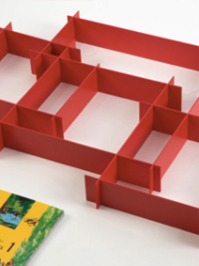Organizational Development
Nº 33
Building a Successful Team
“You never change things by fighting the existing reality. To change something, build a new model that makes the existing model obsolete.”
-Richard Buckminster Fuller
Bucky, as many called him, was an American architect, systems theorist, author, designer and inventor. He studied at Harvard University, but was expelled for his “irresponsibility and lack of interest.” By his own appraisal, he was a non-conforming misfit. At that time quite a bold step!
I am fond of misfits and, naturally, love his statements.
I once had a management speaker declare: “I always want to have at least 1 person in my team who disagrees with me – it allows me to rethink to either defend my view or to change”.
Sesil discussed in an earlier article the essential elements of a successful team:
- Effective teams have trust at their core.
- Effective teams engage in unfiltered conflict around ideas, and manage differences constructively.
- Effective teams commit to final decisions and agreed plans of action.
- Effective teams hold one another accountable for delivering on agreed action items.
- Effective teams focus on achievement in regards to collective results vs. individual results.
No.1 is key – if there is no trust you can forget about all the rest, as well as any further development as a team.
One rarely gets the opportunity to build a new team from scratch, carefully selecting different personality styles (ie. complementary skill sets, trust in one another). It has to grow and develop.
Normally, we enter a team setting already in place. That forces us to play with the cards we’re dealt, so to speak, and fit ourselves into the existing dynamics. Now my question to you: How many of you enter a team and have an immediate gut feeling of likes/dislikes, trust/mistrust, and who is easy to work with? And what happens if you soon realize there is a misfit among you?
It takes me some time, very carefully and consciously with an almost neutral approach, to step back from my first subjective measurement and look at it as an opportunity.
We are so caught up in delivering on objectives that we don’t take, or find, the time to get to know each other. But that is the key – you need to slow down in order to move forward to become as bonded and effective as you need to as a team.
So how do I do that?
Developing team ground rules (see some samples of ground rules at the end of this article) :
– We always develop those at the start to get some clarification on why we are here and what needs to be achieved. We capture them on a flip chart and expect buy-in from all team members. If done so, great! Do we live by and apply those rules on a daily basis? Not necessarily! Why? Because at the core, I am not sure if I can trust every team member. There definitely is a willingness, however time will tell….
 There’s a team development activity I use often. Personally, I think it’s fantastic, letting you recognize team dynamics in a very short time: different personality types, ambitions, and behaviors. It’s called “Performance Puzzle,” and I find it brilliant, fun and insightful. You can play it with a group of 4-5 people as a stand alone – larger teams can split into 2-3 working groups.
There’s a team development activity I use often. Personally, I think it’s fantastic, letting you recognize team dynamics in a very short time: different personality types, ambitions, and behaviors. It’s called “Performance Puzzle,” and I find it brilliant, fun and insightful. You can play it with a group of 4-5 people as a stand alone – larger teams can split into 2-3 working groups.
The game leads to robust discussions, incorporating insights into the business environment, and developing team ground rules. Make sure you regularly follow up on the ground rules – so that it is a living document.
Guiding Rules / Ground Rules samples:
- Provide constructive feedback
- Fully endorse the mission and awareness in interactions with different functions
- Support each other with team spirit attitude
- Positive and constructive thinking
- Instill a “never give up” philosophy
- Escalate if needed
- Trust and communicate openly
- Listen attentively and actively
- Be humble and determined towards our objectives
- Before asking ourselves, how others can change behavior, let’s see how we ourselves can change
If you want to further develop some of those rules, please be sure to discuss it in detail with your team so that there is a common understanding how to act on them.
Ensure that each team member contributes — if there is too little engagement, pair them up, ask them to use Post-it notes to summarize their understanding, and have them present that back.
Soon I will be talking about No. 2 of team development: Effective teams engage in unfiltered conflict around ideas and manage differences constructively.
☺
Which Leadership Behaviors Drive Positive Employee Outcomes?

Leaders are a key element of any workplace: they playRead more…



Comments are closed.